Multi Hazard Early Warning System launched in Muscat
Mar 25, 2015
Categories:
Projects
Oman’s Directorate General of Meteorology and Public Authority for Civil Aviation (DGMET/PACA) launched the Multi Hazard Early Warning System (MHEWS) on March 23, 2015. SeisComP3 and many gempa Products are the key components for earthquake analysis and tsunami early warning.

System Architecture showing the data acquisition, processing, decision support and dissemination components of the Tsunami Early Warning System
System Architecture
The picture on the right illustrates the system architecture of the Tsunami Early Warning System. The gempa CAPS server is used as the central acquisition point for seismic, tide gauge, GPS and wave radar data. SeisComP processes the seismic data and generates earthquake solutions. In addition the focal mechanism of the source region is calculated by the gempa moment tensor module .
Subsequently the Tsunami thread is calculated by the gempa decision support support module TOAST. TOAST uses both, a pre-calculated scenario database and the on-the-fly simulation Easywave, to estimate the wave height and arrival times for various warning zones. Using the computing power of modern GPUs the on-the-fly calculation is done in less the 10s for an event in the Makran Zone and a bathymetry grid of 1 minute resolution. The different scenarios are verified with the data of the various sensor systems and the best matching scenario is proposed for dissemination.
Finally the gempa Dissemination Server (GDS) will send out different bulletins in Arabic and English language to the DGMET staff, the stakeholders (e.g. fire departments, civil defense) and the general public. The GDS uses various dissemination channels such as TV overlay and Cell Broadcast.
Simulation of Tsunami wave propagation triggered by M8.0 event in Makran Subduction Zone
